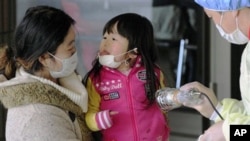As the nuclear crisis continues in northeastern Japan, the government is telling people near the damaged Fukushima-Daiichi reactors to stay indoors. The US government is warning Americans already in Japan to stay at least 80 kilometers away from the reactor site. Many people in the U.S., China and Russia are reportedly stocking up on potassium iodide pills to protect themselves against any wind-borne radiation. While there are many uncertainties about the public health situation in Japan, much is known about the health effects of radiation.
Tens of thousands of people in Japan have been scanned for radiation exposure by medical teams wearing white suits and carrying Geiger counters. When radioactive iodine enters the body, it settles in the thyroid. Children are especially vulnerable.
When the Chernobyl nuclear reactor in Ukraine exploded in 1986, people living nearby were exposed to unusually high levels of radiation. Experts say more than 6,000 children developed thyroid cancer as a result of that exposure.
"Radioactivity is bad for children because it can damage DNA and affect the way cells divide. And children have cells that divide more rapidly than adults because they are growing," said Dr. Edwin Lyman, who is with the Union of Concerned Scientists.
Confusing terminology
Health experts now know that some of these cancers could have been prevented if the children had taken potassium iodide before being exposed to the radiation.
Unless a person is scanned, it is impossible to know how much radiation the body has absorbed.
The terminology can also be confusing.
"One way of measuring is through rem,” said Dr. John Soh, chief of radiation oncology at the Cleveland Clinic. “Another way is the sievert. And because the seivert is a very large unit, we typically measure things in milliseverts. And just to give you an idea, a chest x-ray is about 0.2 milliseiverts," Soh stated.
Dr. Soh says the average person should not be exposed to more than one milliseivert per year. If a person were exposed to 17 seiverts or 1,700 rem, it would likely result in a fatal cancer.
Thursday morning, Kazuo Ymanaka, a spokesman for the Japanese power plant, sought to reassure a frightened populace that the radiation levels around the damaged reactors were going down.
"The changes in the level of radiation as of March 17, today at 9:30 was 3,786 microsieverts per hour. An hour later at 10:30, it went down to 3,750 microsieverts, a bit lower than previously," he said.
Hourly exposure crucial
Professor Robert Baker from Texas Tech University has studied the radiation effects around Chernobyl.
"The amount of radioactivity that kills humans is a substantial amount. If you don't get that much radiation, then the effect for the rest of your life is not easily measured," Baker said.
What counts is not only the amount of a one-time, immediate exposure, but how much radiation a person is exposed to per hour, or regularly over weeks and months. An exposure of four or five seiverts per hour could require a bone marrow transplant.
A review by the Massachusetts Institute of Technology says the highest radiation levels so far at the Fukushima plant have been around 400 millisiverts, rates that are high enough to cause radiation sickness within two or three hours. That level quickly dropped and other readings have been far lower. And the levels also drop quickly the farther away from the damaged plant the measurements are taken.











